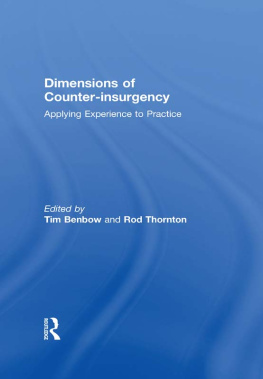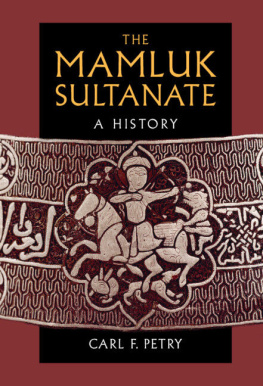Preface
It may seem difficult at the beginning of the twenty-first century to remember that Oman was racked in recent times by internal strife and competing ideologies. The Oman of today is a rapidly modernizing peaceful state where dissent is minimal and largely timid. While the country displays sectarian and ethnic differences, these have little importance in todays political and economic situation.
But for much of the twentieth century, Oman was divided, principally between Sultanate and Imamate and between north and south. These two fundamental schisms and the wars they provoked constitute the subject of this study. Oman has not warred with its neighbours for centuries, perhaps the last significant time being when the forces of Irans Nadir Shah were expelled from Oman in the mid-eighteenth century. However, internal strife has been a recurring theme. The imposing fortresses that dot the countryside and the numerous watchtowers sitting above every village did not appear by happenstance.
Over the course of the twentieth century, the prevailing form of government in Oman, the Sultanate, withstood a number of challenges to its position and authority. These challenges were primarily military in nature and secondarily subversive. They ranged from the traditional, championing a return to a tribal-based theocratic minimalist government, to the radical, seeking to advance the tide of Marxist revolution through Oman into the Gulf. The Sultanates successful responses were political as much as military and, particularly in the post-1970 era, integrative rather than repressive.
For most of Oman, these were not revolutions, that is, spontaneous outpourings of opposition by a significant proportion of the population. The opposition of the 1950s, following the capture of the interior in 1955, was restricted mainly to one major tribe and part of two other tribes, with limited support from some allied tribes. The war in Dhufar in the 1960s and 1970s did not affect the majority of the population in the north of Oman. Even in Dhufar, in the south, the fundamental spur for most dissidents was the local policies of the ruler. Once he was removed in 1970, support for the Front gradually dwindled as it increasingly sought to impose political and social change on the population of areas under its control.
The Sultanate is a relatively new system of government in Oman, metamorphosing from the more traditional Imamate system in the late eighteenth and early nineteenth centuries. At the end of the nineteenth century, the Sultanate appeared to be so weak that it could not withstand internal challenges without British assistance. A quasi-Imamate reigned in Muscat from 1868 to 1871. In 1895, the state tottered on the brink of extinction when tribesmen united under the banner of a renewed call for the Imamate occupied most of the capital at Muscat before being persuaded to leave. The 1913 election of a new Imam led to the Sultanates loss of control over most of the interior, which it accepted by the 1920 Agreement of al-Sib.
A century later, the Sultanate reigns supreme in Oman; its legitimacy is fundamentally accepted; its role in foreign affairs is unquestioned and respected throughout the region; its functions in providing government services and the distribution of the benefits of oil income have gained it nearly universal support; its military and security forces form one of the largest and most efficient entities in the country (in terms of administration and social advancement as well as military and security capabilities), yet the Sultanate does not rule by military force or intimidation.
This study examines the challenges to the Sultanates supremacy and the Sultanates responses to these challenges. In large part because the challenges adopted a violent strategy of dissidence, this book concentrates on the military aspects of the Sultanates response. At the same time, however, it should not be ignored that much of the Sultanates success owes as much to appropriate political strategies as to military supremacy. It should also be noted that while the Sultanates successes were achieved with substantial external assistance, especially from Britain, the principal challenges of the 1950s1970s were also mounted and sustained with the help of equally significant external assistance. In other words, the struggles may have consisted of internal wars, but the actions, organization and armaments of the opposing sides were shaped by external forces acting in the name of broader ideologies and interests.
Inevitably, since the challenges were mounted against a sitting government, their nature was insurgency. The Sultanates necessary response was reliance on counter-insurgency methods. The development and utilization of counter-insurgency tools lie at the heart of the following narrative. These factors, as well as the rugged topography involved, meant that the struggle centred on guerrilla warfare. The Sultanates success in this aspect was in marked contrast to the experience of many other small wars of the post-World War II era. This may have been due in part to the way in which the counter-insurgency campaigns were managed. However and more importantly this study contends that success was due to the reconciliatory approach of the Sultanate, and to its ability to carry out the functions demanded by its people and achieve the legitimacy expected of the state, at least in the short to medium term.
It should be noted that the present study does not pretend to present a normative view of whether the Sultanate should have remained unvanquished. Indeed, there still remain many unanswered if largely theoretical questions about the role of Ibadism in Oman, the legitimacy of the Imamate in the modern era and the right of the Sultans to claim the Imams mantle of religious as well as temporal leadership. Rather, it accepts that the Sultanate has been victorious and that the story must proceed from the victors point of view.1
Much of this book is written from the perspective of the Sultanate, rather than the opposition movements. There are two reasons for this. First, the documentation from the Sultanate side is far more extensive. More importantly, the Sultanate was the victor in these conflicts. This observation is not as flippant as it may appear at first glance. If history belongs to the winners, the Sultanates story will certainly prevail. But this study does not seek to extol the inevitability of the Sultanates victories. Rather, its principal purpose is to explain how the Sultanate, a relatively new addition to Omans political history, withstood challenges to its weak being and firmly established itself as the permanent and seemingly legitimate form of government in Oman, for today and for the foreseeable future.
The forgiveness of the specialized reader is asked for the omission of detailed footnotes on sources in the substantive body of the work. An extraordinary number of documents in various countries were consulted and exploited for this book, as well as hundreds of interviews. I have chosen to omit the footnoting of these sources since citing each relevant source for each statement would have made the book extremely cumbersome. Instead, I have added more general footnotes at the beginning of sections to indicate the main published sources, and a short essay on references can be found at the beginning of the bibliography.
A note on terminology may be in order. The term Sultanate has been used throughout to indicate the state headed by the Al Bu Said family and based in Muscat since the beginning of the nineteenth century, even though the title Sultan was not adopted by these rulers until the twentieth century. Similarly, the term Imamate has been employed throughout both to indicate the traditional institution that governed Oman for much of the past millennium, and to refer to the post-1955 opposition movement (sometimes styling itself the Imamate of Oman or the Oman Revolutionary Movement) to the Sultanate in northern Oman. I have generally chosen to call the struggle between this last Imamate and the Sultanate the war in northern Oman rather than the more common al-Jabal al-Akhdar war, as the latter term refers to only one part of the struggle. For the south, war in southern Oman and Dhufar War are used interchangeably.











